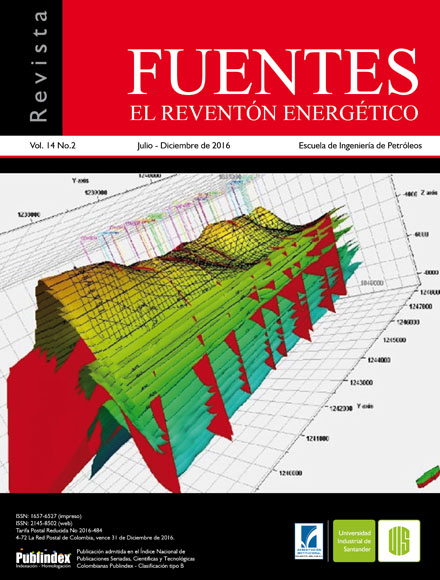Modeling the proppant fines mobility on productions trends for hidraulic fractured wells
Published 2017-01-30
Keywords
- Proppant fines,
- Hydraulic Fracturing,
- Production Trends,
- Cyclic Stress
How to Cite
Copyright (c) 2016 Fuentes, el reventón energético

This work is licensed under a Creative Commons Attribution 4.0 International License.
Abstract
In general terms, hydraulic fracturing is the physical -mechanical process of creating fractures in the formation in order to provide highly conductive flow channels to accelerate the total production. To this end, the injection of a highly viscous polymer fluid accompanied by particulate material called proppant material whose main function is to keep open the fissures in the rock.
The application of efforts by the rock that comes into contact with the fracture proppant material begins a crushing process. This phenomenon gives rise to the gradual appearance of proppant fines, which have the ability to be transported and deposited spatially throughout the proppant pack, thereby generating affected areas with partial obstruction or total highly conductive channels. This process occurs throughout the productive life of the fracture and has its greatest influence during the execution of chemical stimulation treatments through the proppant pack.
This study presents a new engineering approach that enables quantification of the impact generated by the mobilization and redistribution of the proppant fines banking on altering the effective fracture conductivity and its associated production. A Single Well Model (SWM) was created using Local Grid Refinement (LGR) to represent the partial fracture conductivity reduction, this model allowed to recreate the different distribution patterns in order to obtain the production trends after a remedial chemical stimulation event. The results show percentages of detrimental production between 9 to 30% compared to the base case production. The results indicate that the effect of the various distribution patterns of form caused by the re-mobilization of proppant fines banking generates significant and sustained levels of production reduction. This negative factor should be minimized during the well intervention involving the injection of fluid along the deteriorated fracture. In addition, it was found that this type of interventions, not only must be performed at matrix injection rates, but also considering a control strategy similar to those used in wells with high production of formations fines.
Downloads
References
- AMERICAN PETROLEUM INSTITUTE
- Recommended Practice 19C ISO 13503-2,
- ‘‘Measurement of Properties of Proppants Used in
- Hydraulic Fracturing and Gravel Packing Operations”.
- Section 11. Proppant Crush-Resistance Test.
- Washington D.C. U.S. May 2008. P. 23-27.
- AZARI M., ‘‘Performance Prediction for Finite-
- Conductivity Vertical Fractures” Society of Petroleum
- Engineers, SPE-22659. SPE Annual Technical
- Conference and Exhibition. Dallas, Texas, U.S. October
- -9, 1991. P. 2, 3, 4, 6.
- CINCO-LEY H., SAMANIEGO V.F., ‘‘Effect of
- Wellbore Storage and Damage on the Transient
- Behavior of Vertically Fractured Wells”. Society of
- Petroleum Engineers, SPE- 6752. Mexican Petroleum
- Institute. Denver, Colorado, U.S. 9-12 October 1977.
- P.2, 3, 6.
- CINCO-LEY H., SAMANIEGO V.F., DOMINGUEZ
- N., ‘‘Transient Pressure Behavior for a Well with Finite
- Conductivity Vertical Fracture”. Society of Petroleum
- Engineers, SPE-6014-PA. Mexican Petroleum Institute.
- Ciudad de México. México. August, 1978. P.3, 4.
- ECONOMIDES M., VALKÓ P. ‘‘Optimization of
- the Productivity Index and Fracture Geometry of a
- Stimulated Well with Fracture Face and Choke Skins”.
- Society of Petroleum Engineers, SPE-81908-PA.
- University of Houston. Houston, Texas, U.S. February
- P.1.
- GIDLEY J.L., ‘‘A Method for Correcting Dimensionless
- Fracture Conductivity for Non-Darcy Flow Effects”.
- Society of Petroleum Engineers, SPE-20710-PA. John
- L. Gidley and Associates. Inc. Houston, Texas, U.S.
- November 1991. P.1, 2, 5.
- GUPPY K.H., CINCO-LEY H., RAMEY H.J., ‘‘Non
- - Darcy Flow in Wells with Finite-Conductive Vertical
- Fractures”. Society of Petroleum Engineers, SPE-
- -PA. Standford University, Society of Petroleum
- Engineers Journal. Standford, California, U.S. October
- P.3, 5.
- LEHMAN L., PARKER M., BALUCH M., HAYNES
- R., ‘‘Proppant Conductivity – What Counts and
- Why”. Society of Petroleum Engineers, SPE-52219.
- Halliburton Energy Services, Inc. Mid-Continent
- Operations Symposium. Oklahoma City, Oklahoma,
- U.S. March 1999. P.2, 3, 4.
- MONKHOUSE E. J. Diccionario de términos
- geográficos. Barcelona: Oikos Tau-Editores. (1978). p.
